NORTH WALES COAST RAILWAY:NOTICE BOARD
Rheilffordd arfordir gogledd Cymru: Hysbysfwrdd
16 November 2020





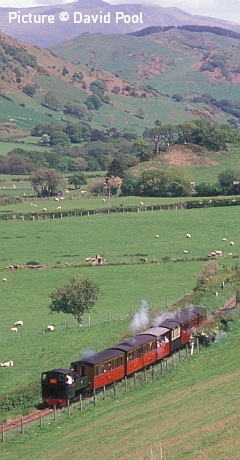
Forthcoming events
(see also our Calendar page for venues)
Note: we have removed all entries relating to meetings as the events are cancelled.
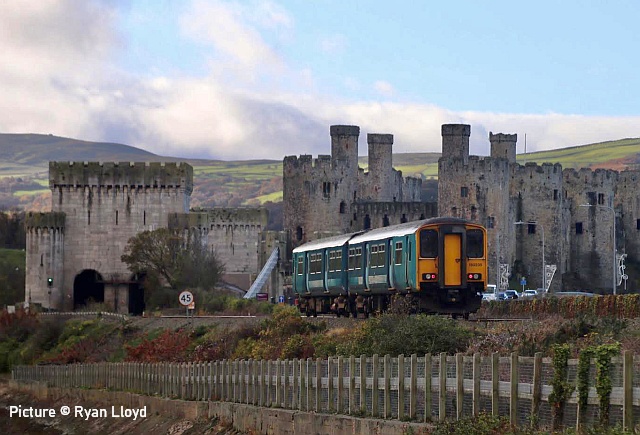
150 235 approaching Conwy working 1D34 Manchester Piccadilly to Holyhead
12 November. Picture by Ryan Lloyd.
Thanks for the various contributions received regarding Sleepein cars and Motorail: I've held them over while I study them a little. - Charlie
RHTT views
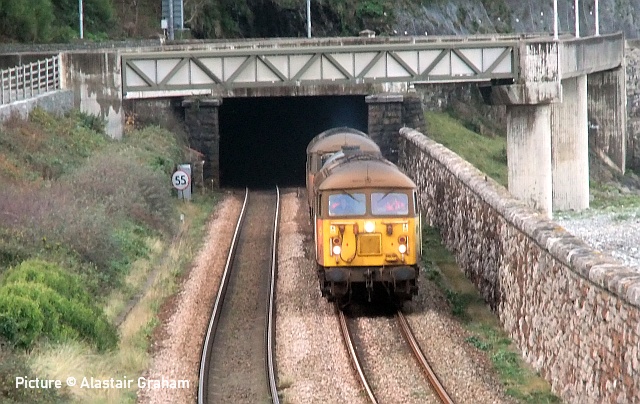
Rail Head Treatment Train departing Penmanbach tunnel at Conway Morfa 14 November, with 56 096 (Alastair Graham) ...
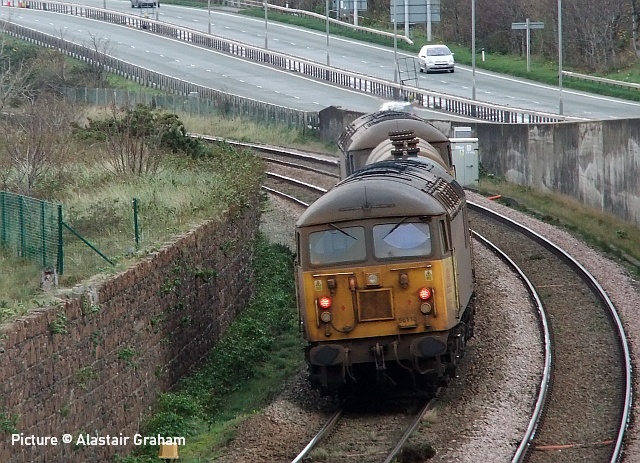
... and 56 113 (Alastair Graham). Current regulations in Wales state 'There are no travel restrictions in place within Wales. However, we are asking everyone to think carefully about the journeys they take and the people they meet.'
Alastair lives in Wales, so he's OK . However, he isn't allowed to leave Wales without a defined reason. People in England can travel 'to spend time or exercise outdoors - this should be done locally wherever possible, but you can travel to do so if necessary (for example, to access an open space)'. Don't cross the Welsh border though, as you won't be allowed to leave...
Chirk Logs - report by Ian Pilkington
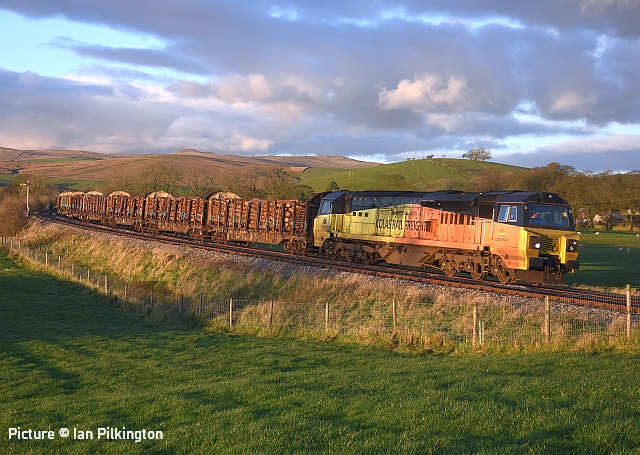
70 810 heads away from Hellifield with 6J37 Carlisle Kingmoor - Chirk logs on Wednesday 4 November 2020. The train started to run again on 1 September; I understand it ceased operating in February due to work commencing on a major expansion of the factory. The train initially recommenced running on 1st September, but only intermittently for a few weeks. Can any reader offer more information?
Cambrian milestone - by Chris Magner
One of the greatest ever events in the history of the Cambrian Coast Railway was on Saturday 18th November 1972, forty-eight years ago, The Cambrian Coast Line Action Group ran their special train from Pwllheli to Euston for a March to Downing Street to save the line from closure. The local MPs handed in a petition to keep the line. The special was arranged at short notice and credit was due to the railwaymen of Stoke Division for their efforts as it was not easy running a train from Pwllheli when the locomotives (2x24) and coaches were based in the West Midlands.
Without doubt the publicity over this train helped to reprieve the line. Sadly, no railway operators who have run the line since have ever given credit to CCLAG for saving the jobs of many Welsh railwaymen. One hopes this train and march will never be forgotten. This was Welsh local action at its best.
Capacity checker
Transport for Wales have introdiced a 'capacity checker' on their website. The idea is that you enter your proposed journey and it will tell you whether there are 'Seats likely to be available, (green blob), 'Fewer seats available for social distancing' (yellow blob) or 'Trains expected to be busier with few or no seats available for social distancing' (red blob).
It seems a little fiddly to operate, there are many gaps in the data, and it's not clear exactly how users are supposed to react, but it's an interesting idea. Really, though, it should be combined with the normal journey planner.
45s on the A55 - by 'Skimpler'
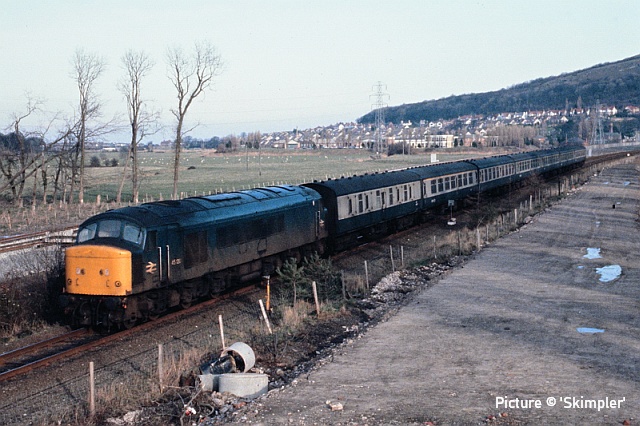
Following on from my '25s on the 55'. here are 45s. These are taken at the site of the former Mochdre and Pabo station, also allegedly the location, roughly, of the first water troughs in the world. There was a signal box too splitting the section between Llandudno Junction No1 and Colwyn Bay, closed 1967.
Taken in early 1984 during the works to move the Railway north a little bit to make room for thousands of lorries to go to and from Ireland, the first picture (above) shows 45 120 on a Scarborough to Llandudno working. The way has been cleared for the westbound carriageway of the A55 but the down main line is still in its original location. Just to the left of the engine, the two new tracks are in place. The two tracks were separated here and the existing up main line is hidden by bushes in the '6-foot' but is still in use at this time.
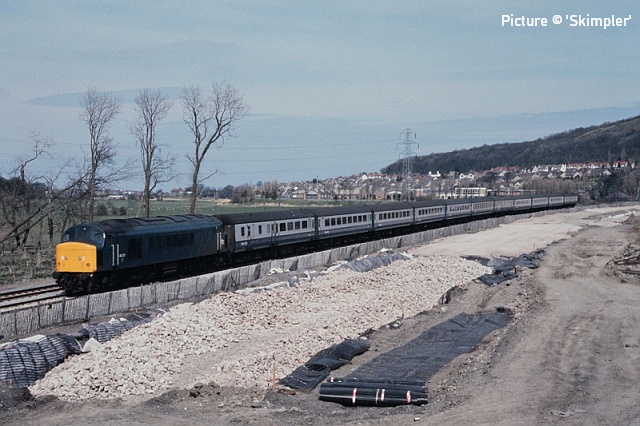
The second picture, three months later, shows 45 128 on 1D43, London Euston to Holyhead passing the same location as trains are now using the new alignment. The old main line removed and the beginnings of the eastbound Carriageway are now taking shape. The three big trees are a bit of a constant between the two views.
From Dave Sallery's archive
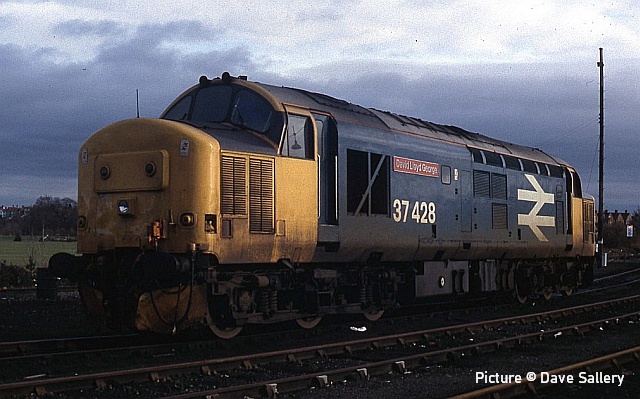
37 428 David Lloyd George in Shrewsbury, stabled on Sunday morning, 20 January 1991.
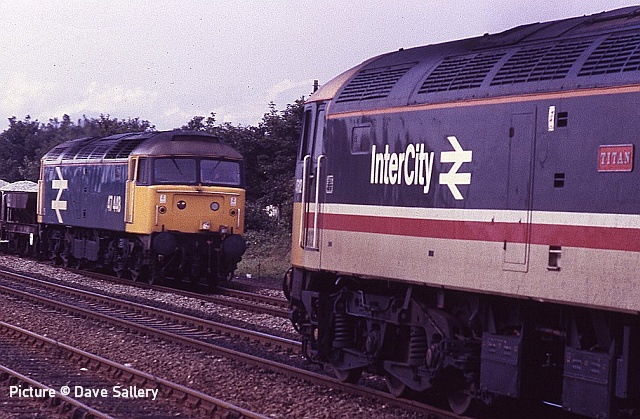
On 16 September 1987 47 612 Titan and 47 448 pass at Prestatyn with Up and Down Penmaenmawr ballast trains at Prestatyn. At that period, locos could be found working a long way away from their 'home depot'. 47 448 was based at Old Oak Common, London, whilst 47 612 belonged to Inverness. In 1989 it was re-numbered 47 838, and in 1994 47 779 when transferred to the Parcels sector.
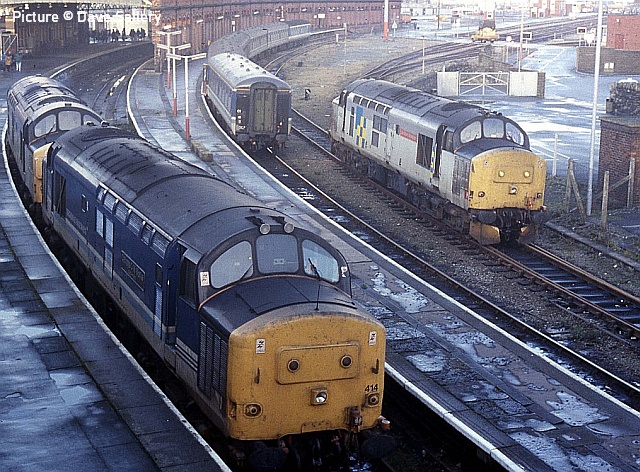
Holyhead, 22 December 1993. 37 414 Cathays C & W Works, an early wearer of the smart Regional Railways livery, coupled to 37 350 which had taken over a passenger from a failed 37 414 at Rhyl. 350, which is in fact the pioneer Class 37 D6700, now preserved by the National Railway Museum, was stabled in Holyhead at the time after arriving on the weekly petroleum coke train. Behind, running round its train, is 37 425 Concrete Bob / Sir Robert McAlpine still in 'construction' colours.
Looking back: Talyllyn, Part 2 - with David Pool
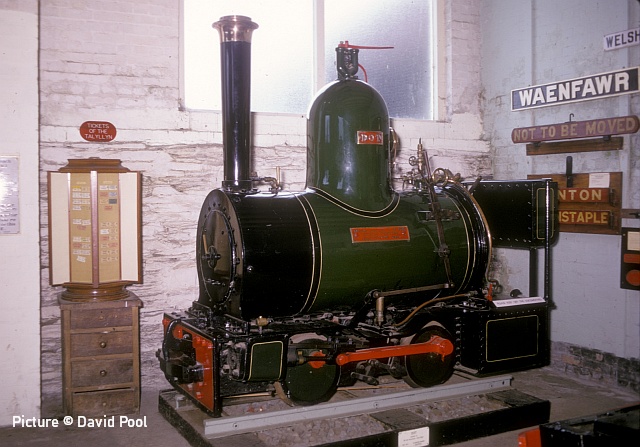
One of the 18 inch gauge locomotives in the Narrow Gauge Museum at Tywyn is Dot, photographed on 24 June 1971. It was built by Beyer Peacock in 1887 for their Gorton Locomotive Works.
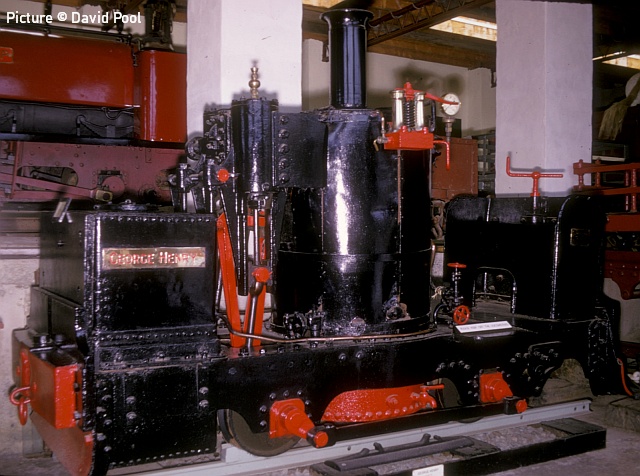
Nearby in the Museum was “George Henry”, a vertical boilered 2-foot gauge locomotive built by De Winton of Caernarvon in 1877 and used in the Penrhyn Quarry
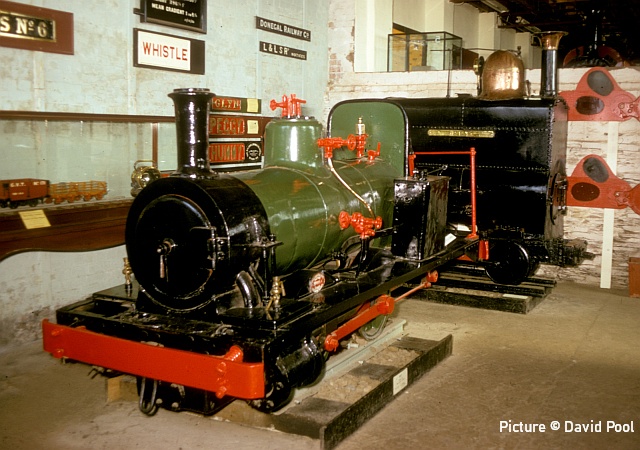
The Dundee Gasworks had a 2 foot gauge railway system, and their locomotive No. 2 was on display on 26 August 1973 in the Museum. This was built by Kerr Stuart, probably in 1901, although 1902 and 1907 are quoted by some sources. In the background is Pet, an 18 inch gauge locomotive built in 1865 by the London and North Western Railway for their Works in Crewe, and used there until 1929. It is now in the National Railway Museum in York.
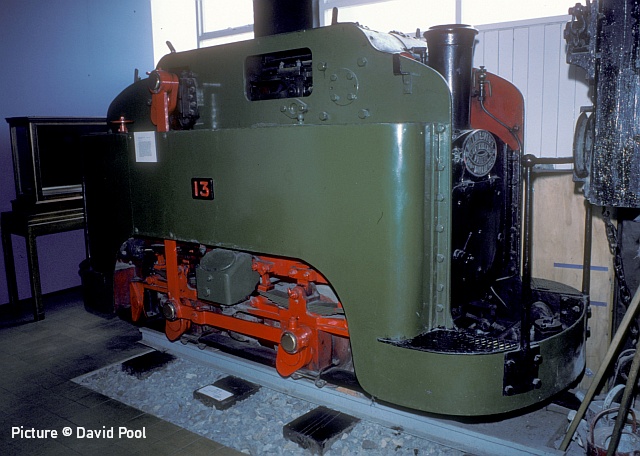
On another visit to the Museum on 14 July 1984 I wanted to photograph Guinness No.13, and I needed a wide angle lens and a flash, since the exhibits tended to be very close together. The Guinness Brewery in Dublin had an unusual railway system, in that there was a 1 foot 10 inch gauge internal network and sidings for the 5 foot 3 inch Irish gauge lines. No. 13 was built by Williams Spence Ltd. In 1895, being one of a small fleet of these narrow gauge locomotives. In order to move Irish gauge wagons within the Works, the narrow gauge locomotives could be mounted in Irish gauge “Haulage Wagons”, in which a system of rollers was used to enable the locomotive wheels to drive the Haulage Wagon wheels.
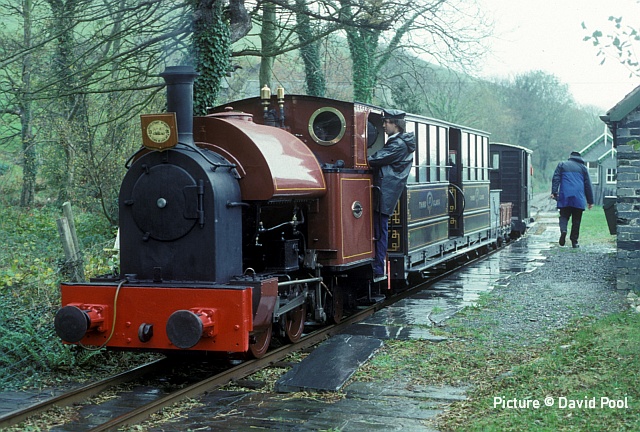
In 1991 the Corris No.3 Sir Haydn had been repainted from the GWR green into a brown Corris livery. It was a wet day on 2 November, as I followed No.3 up the valley. At Brynglas No. 3 is about to depart with its Corris composite coach and a few wagons.
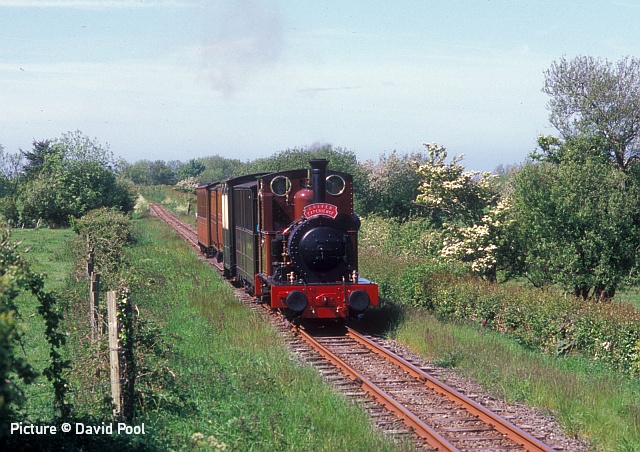
My visit to the Talyllyn on 23 May 2015 was favoured with superb weather. The Railway was celebrating 150 years of operation, and most of the locomotives were in service. “Driver Experience” trains were featured, and No. 2 Dolgoch, with an appropriate headboard, was approaching Cynfal halt. The footpath on the South side of the line from Hendy to Cynfal and Brynglas gives many photo opportunities in comparison with the upper part of the line towards Abergwyolwyn.
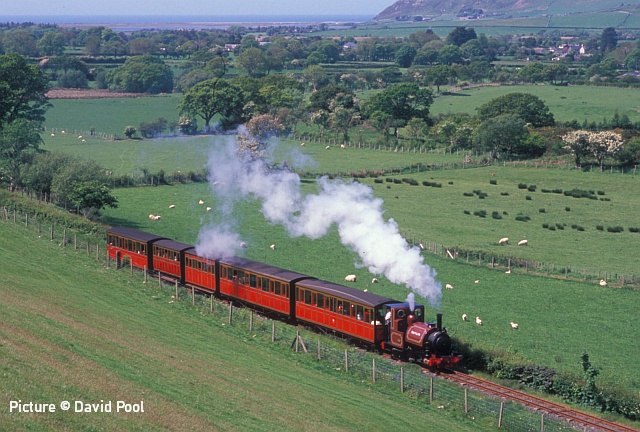
The section of the footpath near Brynglas is now my favourite location for photographs on the Talyllyn Railway. No. 1 Talyllyn, built by Fletcher Jennings in 1864 and now in a brownish-red livery, looked superb as it came up the valley. Trying to frame the train within the field of moving sheep was a challenge!
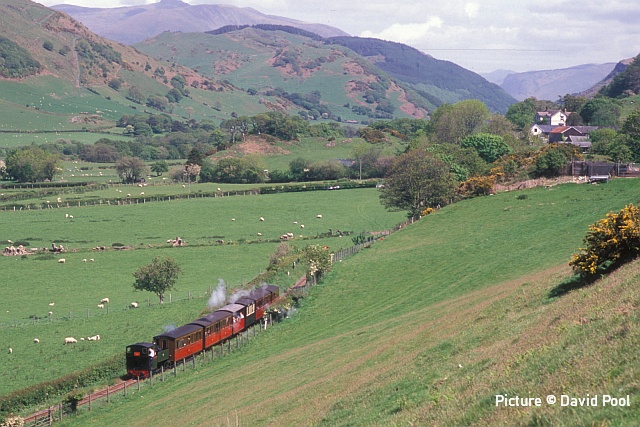
One of the features of the Talyllyn Railway is that the locomotives normally face uphill, and it is not easy to get pleasing photographs of a train is drifting down to Tywyn, when the rear of the cab is the most visible part of the locomotive. No. 7 Tom Rolt has just left Brynglas, and what little exhaust steam it made has now disappeared. This was the Irish Pete I had photographed in 1969, now rebuilt and re-gauged, and a valued member of the locomotive fleet.
Saving the Corris Locos - by Chris Magner
When the Corris Railway closed in August 1948 the track was soon lifted. Mr Edward Campbell Thomas, the Stationmaster at Machynlleth, was very fond of the Corris Railway and he did not want to see the two Corris locos scrapped; this at a time of a national scrap drive. Although he knew that the Talyllyn Railway would need them one day, the Talyllyn did not have the money to buy them. So Campbell Thomas hid the two locos in the lower yard at Machynlleth and had them sheeted over with tarpaulins. With the help of the Machynlleth Motive Power Depot staff he had the two locos greased so they could run again one day. Mr Campbell Thomas only lived for a few more years but he was there in March 1951 when 3 and 4 went to the Talyllyn at Towyn (old spelling). What an amazing effort to save two BR locos for two and a half years. In 2021 No.4 celebrates its centenary. One hopes people will learn about one of the early railway preservationists. Not much is recorded about what Campbell Thomas did for secrecy was the name of the game.
The Hoot and Boot railtour - pictures by Tim Rogers
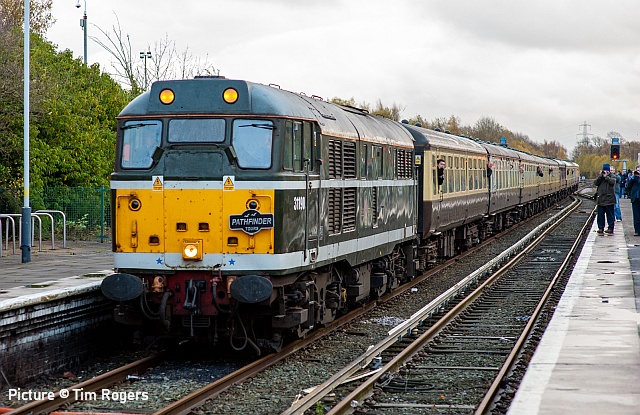
Pathfinders Tours' 'The Hoot & Boot' railtour 1Z23 13:30 Donnington RFT to Eastleigh
via Hooton, Runcorn Folly Lane, Birmingham International & Coventry ran on 14 November 2009 It must have been one of the slowest tour of the year. Above, the train on arrival at Hooton, with 1looking good in the original livery of the class.
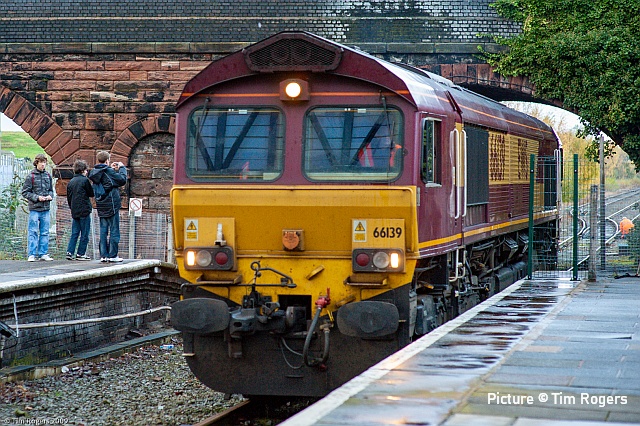
66 139 backs on to the train at Hooton.
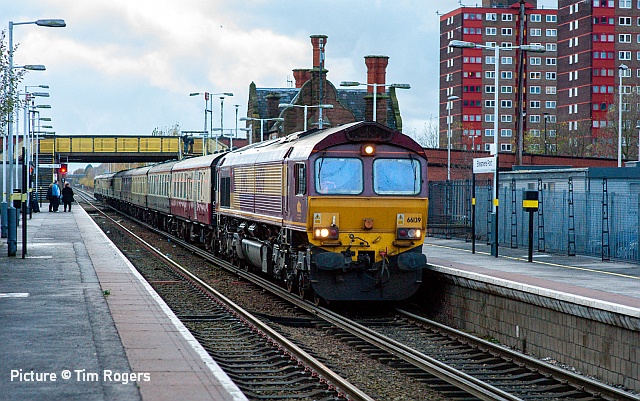
Ellesmere Port...
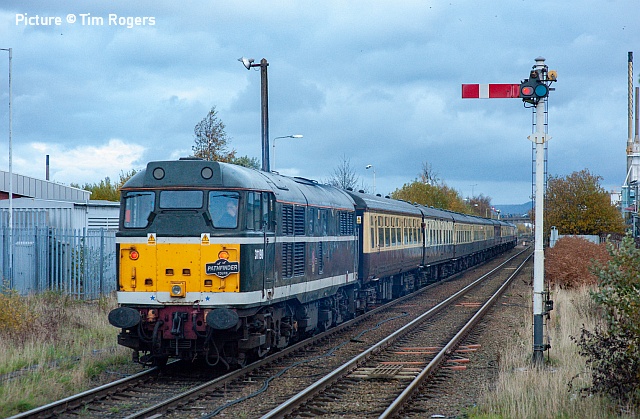
... with 31 190 on the rear.
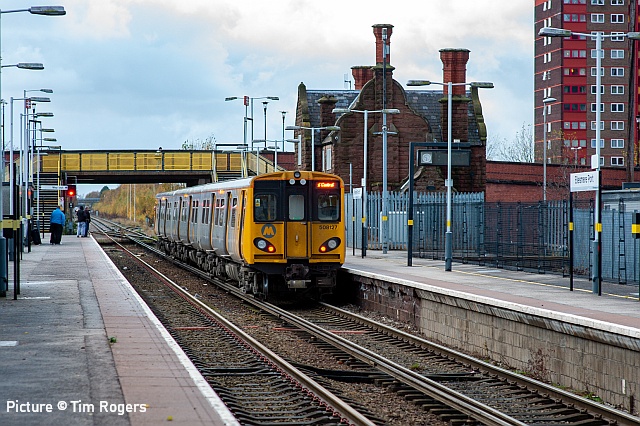
508 127 working 2Y21 15:49 Ellesmere Port to Ellesmere Port via the Liverpool loop; today these units are in their last days, with new Swiss-built units on the way.
Miscellany
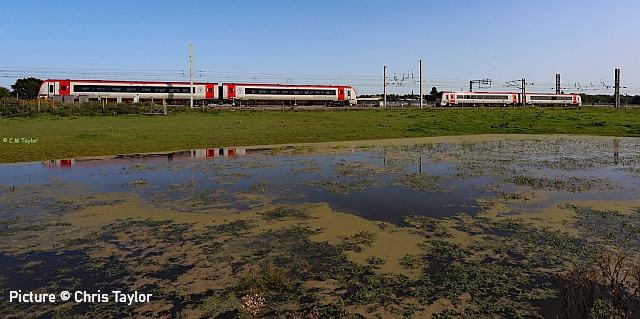
A couple of 175s pass at Winwick Junction, being on the left the 12:35 Manchester
Airport to Chester 1D37 and on the right the 12:52 Chester to Manchester Airport 1H87 on 17 September 2020. The westbound train was running slightly late which resulted in this photo. The field was flooded due recent rain and on the foreground would have been the Sankey Canal - filled in at this point.
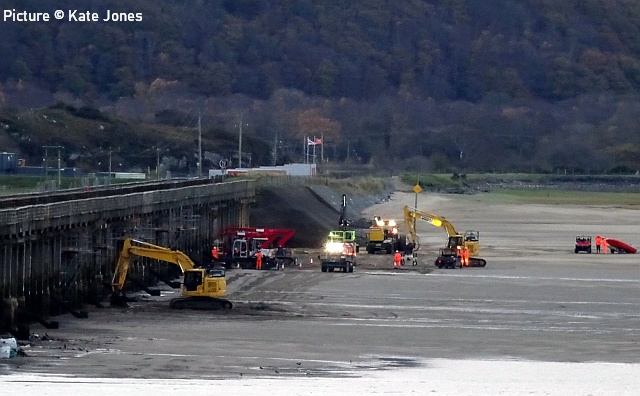
Acrivity by Barmouth bridge, 9 November (Kate Jones).
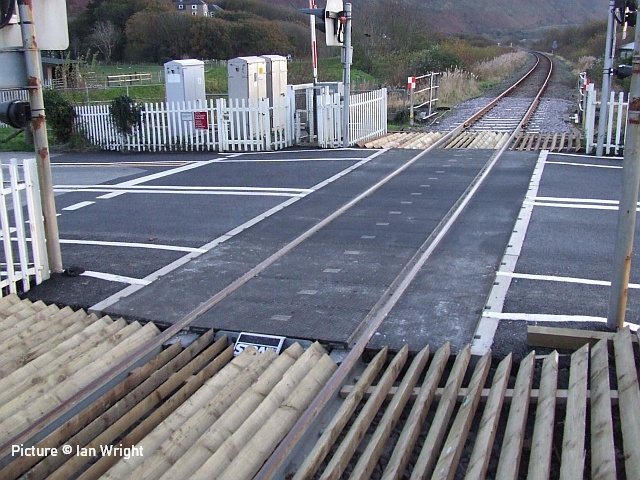
Fairbourne level crossing renewed (Ian Wright).
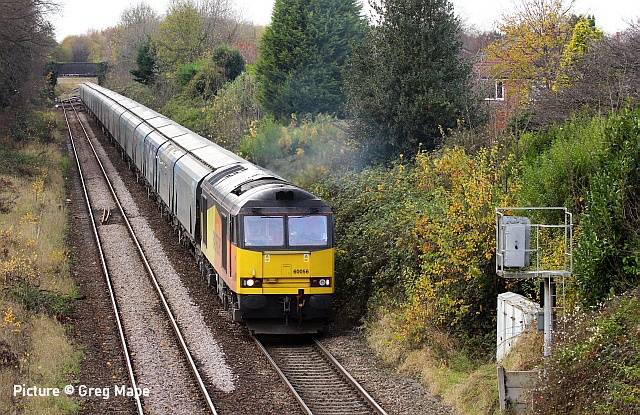
60 056 on a Liverpool - Drax biomass service near Skelton Junction, 13 November (Greg Mape).
Shipping news - by Jim Johnson
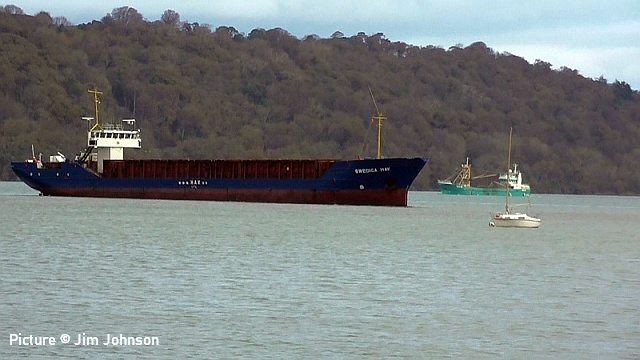
MV SWEDICA HAV sailed from Derry to Port Penrhyn, Bangor, arriving on the
morning high tide of Saturday, 14 November. Its purpose was to load slate waste (also known as 'ornamental garden chippings'). Above, in Hirael Bay, between Bangor Pier and Port Penrhyn. Local mussel boat Valente in the background.
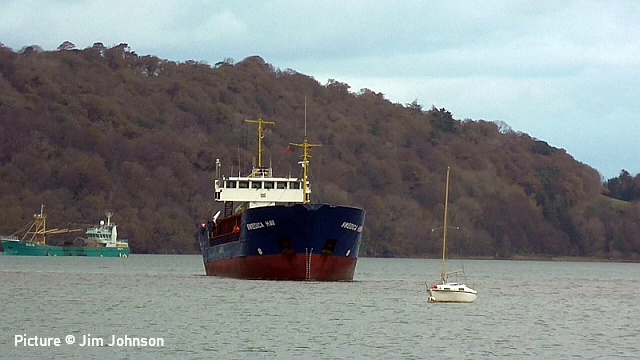
Manoeuvring through 180 degrees, to facilitate stern-first entry to the dock.
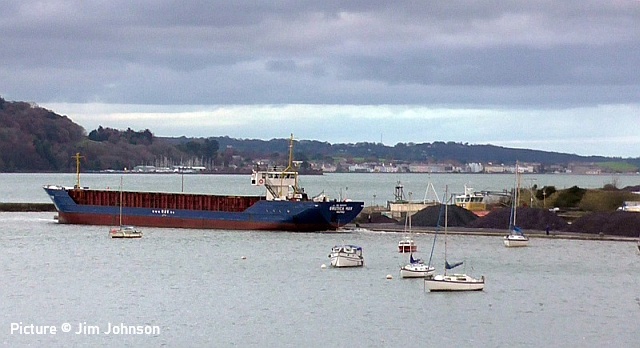
Approaching the dock.
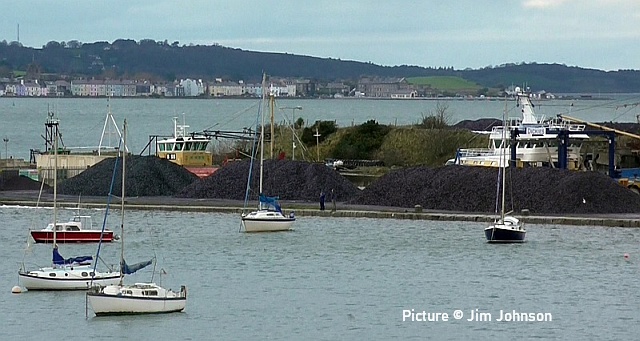
Three separate piles of slate, from different sources: l-r Blaenau Ffestiniog, Penrhyn and Pen-yr-Orsedd.
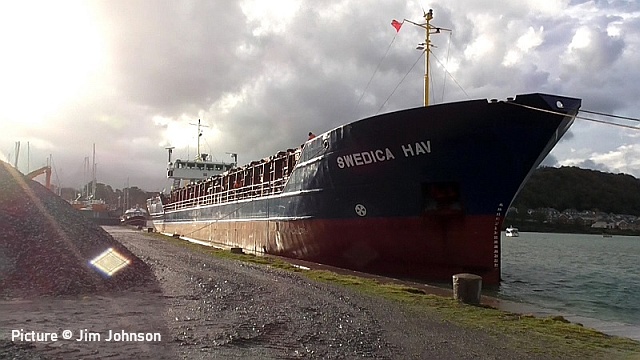
Berthed and ready for loading. See also my video.
Open Day at Northwich, 1980 - remembered by Chris Jones-Bridger
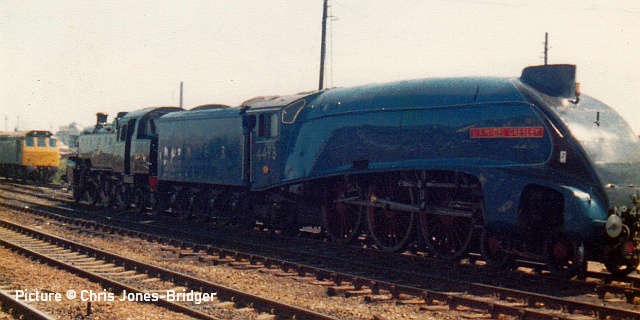
My record of an excellent day on 18 May 1980; the pictures were taken on a basic Kodak 'Instamatic'. The Area Manager Davis Macintosh was especially keen to accommodate as many steam locomotives in Northwich's steam era stabling point prior to the main celebration of 'Rocket 150' over the Bank Holiday.
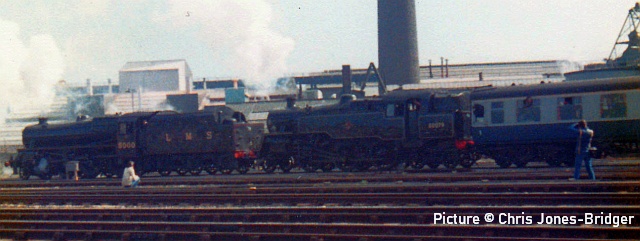
4-6-0 5000 and 2-6-4T 80079 from the Severn Valley Railway had worked 'The Black Countryman' charter from Hereford to Manchester Victoria on 19 April.
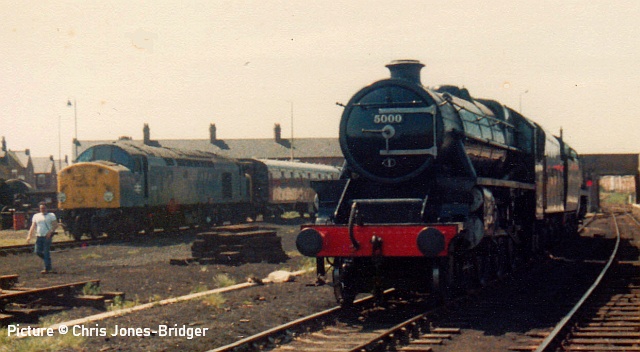
I can't recall exact details of 35028 Clan Line's charter but it did record at Northwich. Nor can I recall how 4498 Sir Nigel Gresley worked to Northwich. The day itself was a great success. The steam locos operated an all day shuttle on the up & down loop between the Northwich station's back platform and the east junction utilising the support coaches.
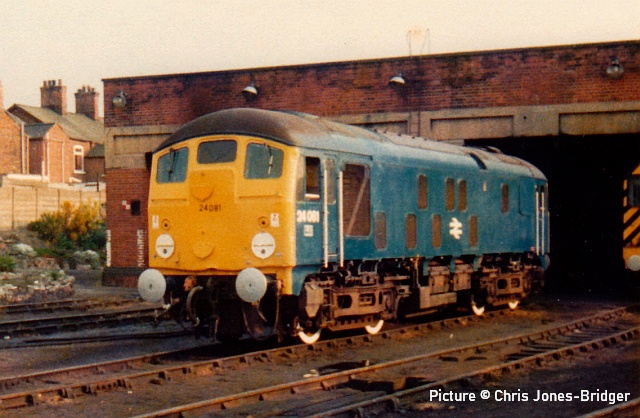
Due to a busy engineering programme and the timetabled ICI hoppers diesels were in short supply. A suitably tidy 24 081 had been specially provided as the last operational example and a class 40 was also present, I don't recall its number [40 119?]. The latter was unavailable for traffic as it had been involved in a
derailment the previous week and was awaiting transfer to a main depot for
assessment & repair.
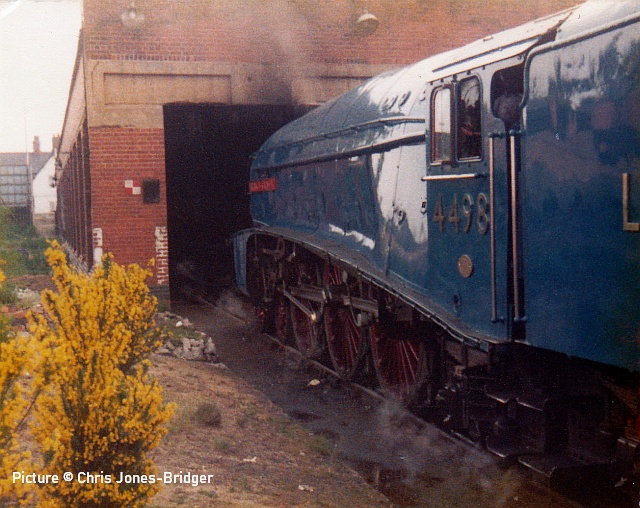
I missed the opportunity to photograph the 'surprise' event of the day when 5000 substituted for the booked banking loco and provided assistance to the last inbound hopper service between Plumley West and Oakleigh. Fortunately I do have a record in my possession from a friend's collection.
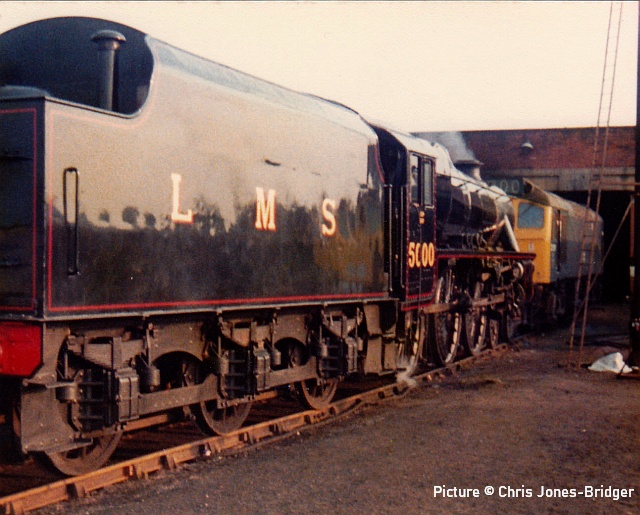
The pictures attached were taken at the end of proceedings when the steam
locos were being disposed of for the day.
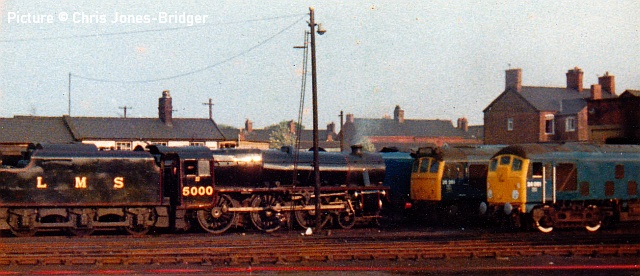
This had included turning moves via Greenbank triangle in order to prepare for the planned transit moves the next day from Northwich to Bold Colliery in preparation for the cavalcades the following weekend. As these transits had been planned via Delamere forest and a high fire risk had been declared due to hot and dry weather diesel pilots were ordered by control arrangement to drag the steam locos in light steam.
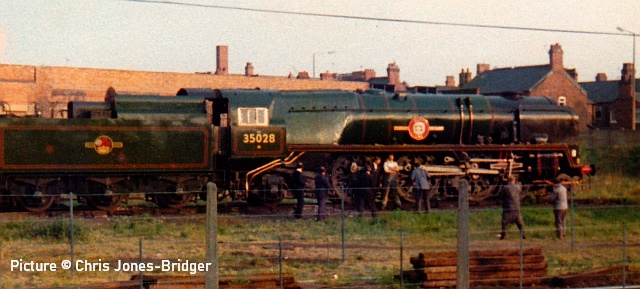
Ironic that on the Monday morning they departed Northwich in a torrential downpour!
Princess visits Holyhead, 2006 - by Ken Robinson
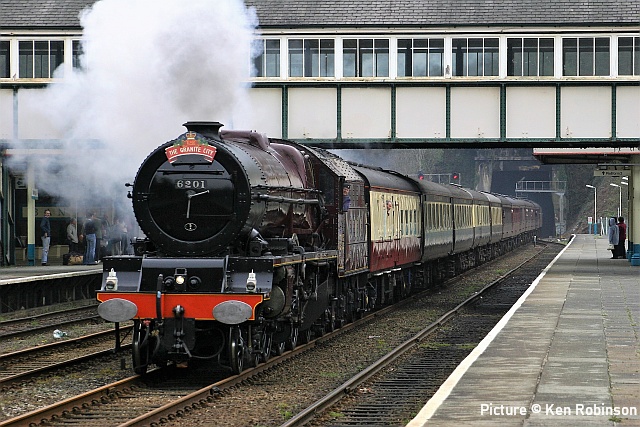
On 22 April 2006, LMS Pacific 6201 Princess Elizabeth worked a railtour, organised presumably by the Princess Elizabeth Society, (there is little information about this tour on the internet) titled 'The Granite City', which I think ran from Euston to Holyhead (steam from Crewe). The first shot (above) shows the train thundering through Bangor.
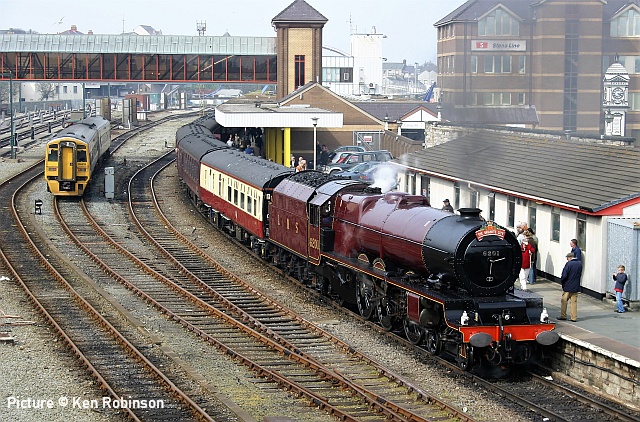
At Holyhead after running round, with 158 826 in the sidings ...
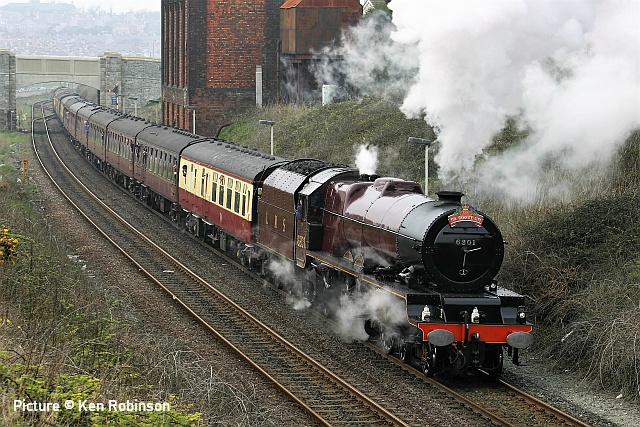
... and third, the departure from Holyhead.
A North Wales Circular Tour in 1964 - by Mark Hambly
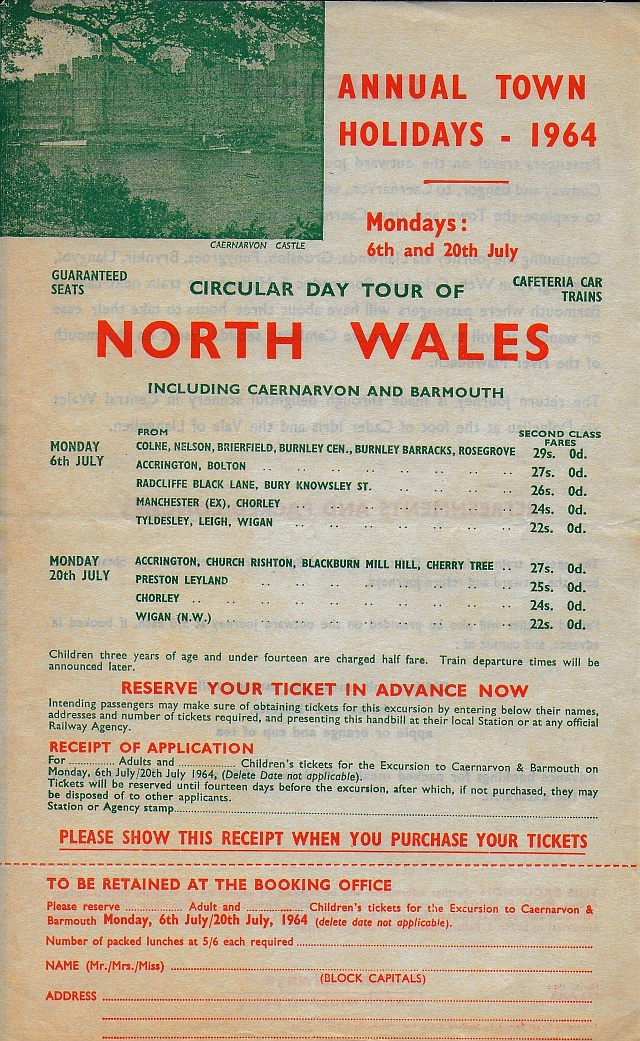
[Note: This article is at this stage informed solely by two handbills and the public timetable applicable on the date the train ran. As such, it contains certain suggestions which remain to be validated, and any alternative suggestions or definite evidence would be welcomed.]
Regular followers of the North Wales Coast Railway Notice Board will undoubtedly be familiar with the various scenic land cruise trains and other local excursions run by BR from the north Wales coast resorts in the 1950s and 60s. Perhaps less well-known is the use of the circular tour format by excursions from further afield, an example of which is the pair of “Circular Day Tours of North Wales” trains run during the annual town holiday weeks from various east Lancashire towns in July 1964, the last year in which the itinerary followed would be possible.
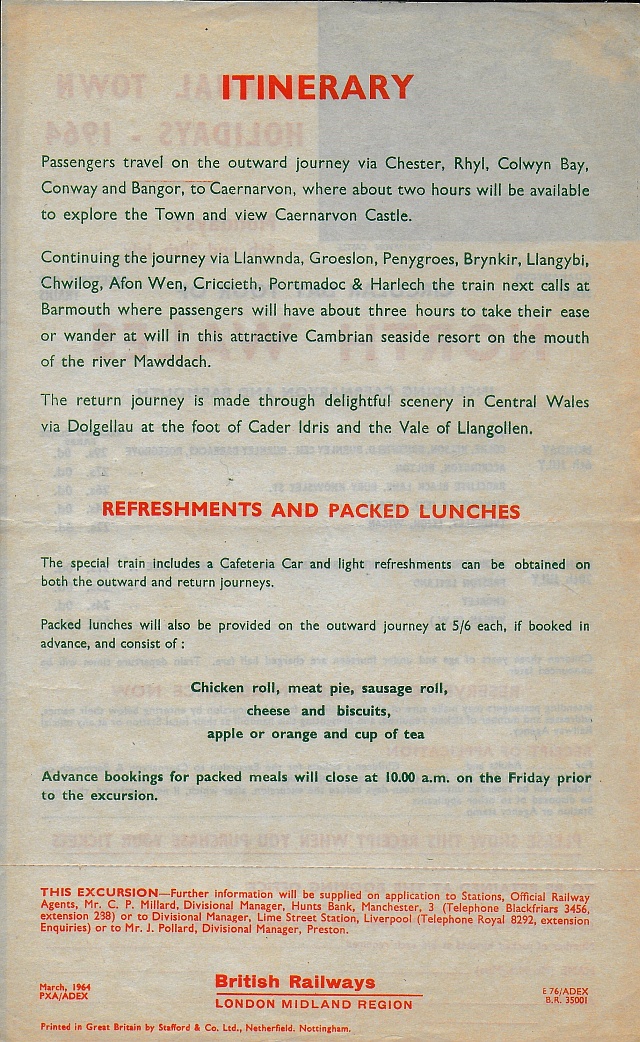
A combined handbill issued in March allowed prospective travellers to make reservations in advance which secured their tickets until 14 days before the excursion, when payment was due.
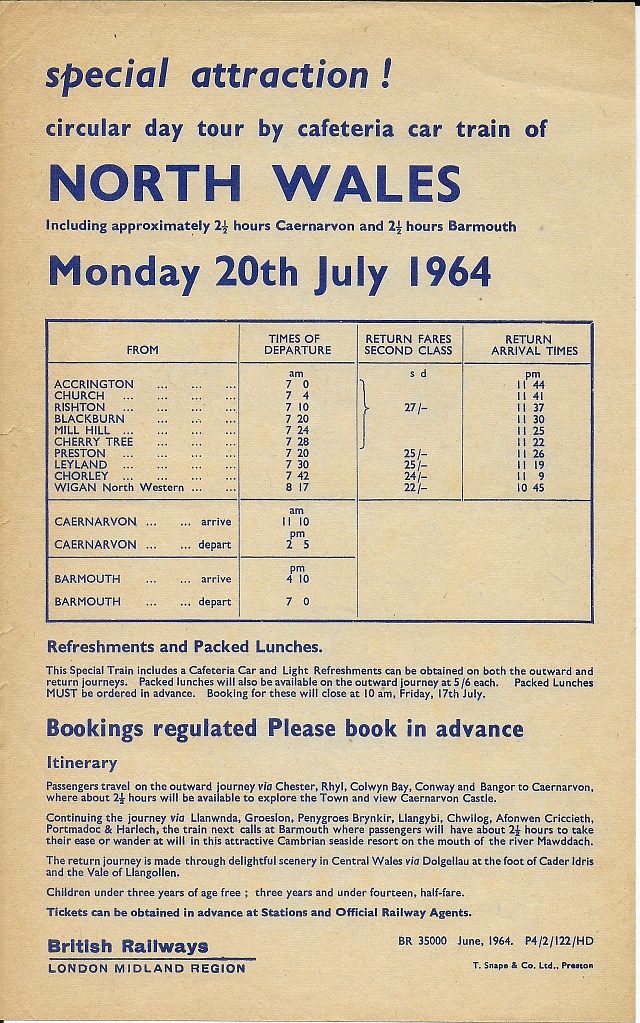
An individual more detailed handbill for each train was issued in June with timings and a reminder of the fares and catering arrangements. The detailed handbill for the train leaving Accrington at 7.0am and Preston at 7.20am on 20th July 1964 allows one some further appreciation of the extent of the day’s tour, although 56 years later and without access to contemporary observations one has no alternative but to speculate on certain aspects of the day, informed in part by the Summer 1964 London Midland Region timetable, my copy of which has incidentally been heavily annotated by its original owner who clearly made use of it while travelling on a rover ticket based on Rhyl.
As the handbill makes no reference to passengers being required to make connections by service train then, based on the timings, there must have been separate Accrington and Preston portions. After picking up at all stations to Cherry Tree, the Accrington portion would have run via the Chorley & Cherry Tree branch through Withnell, which had lost its passenger service in January 1960, to Chorley and then via Adlington and Boar’s Head to Wigan North Western where it combined with the Preston portion which had also picked up at Leyland.
Assuming an on-time departure from Wigan NW at 8.17am, Warrington Bank Quay would have been passed shortly before the departure of the 8.35am to Holyhead, a train it would be essential to be in front of along the North Wales Coast if Caernarvon was to be reached on time at 11.10am. On the last stage of the journey to the day’s first destination our train would have followed the 9.30am from Rhyl through the section from Menai Bridge. With a break at Caernarvon of almost three hours there would have been time for the locomotive to have returned to Bangor shed for servicing if necessary.
Setting off southwards from Caernarvon for Afon Wen at 2.05pm, the 1.55pm northbound local service would have been passed at Penygroes. Once onto the Cambrian Coast the next train of interest would have been the 1.38pm from Dovey Junction to Pwllheli, which the tour train would probably have been held at Portmadoc to pass. A clear run to Barmouth should have then ensued, for an on-time arrival at 4.10pm.
At 7.0pm, after another break of almost three hours, it was time for our tourists to head for home. Setting off 15 minutes ahead of the last eastbound service train of the day from Barmouth to Ruabon, the 5.30pm Pwllheli to Chester, should have ensured a clear run along the Mawddach estuary, up the Wnion valley and past Llyn Tegid before passing the 5.7pm from Birkenhead Woodside to Barmouth at Bala Junction. Reaching Ruabon a little after 9pm it was then on to Wrexham and down Gresford bank to Saltney Junction from where the outward route of over 12 hours earlier through Chester General and Warrington BQ to Wigan NW was retraced with arrival at 10.45pm. The Prestonians’ portion deposited them home at 11.26pm, just over 16 hours after setting out, while for the good folk of Accrington it was 11.46pm when they eventually arrived. Assuming that the timing and duration of the Caernarvon and Barmouth breaks had been the same, those from Colne, Nelson and Burnley who made the trip two weeks earlier would have had an even longer day.
Measured from and to Wigan NW the round trip would have been a respectable 247 miles, give or take a few chains, with the Preston portion covering an additional 15¼ miles each way via the WCML (so 277½ in total) and the Accrington portion 23½ miles each way via Chorley, Adlington and Boar’s Head (so 294 in total).
(Acknowledgement to www.railwaycodes.org.uk for their Engineers’ Line Reference tables from which the Accrington to Wigan NW mileage was pieced together, with the remainder from the Summer 1964 London Midland Region timetable.)
I have not had the opportunity to research the locomotives or rolling stock used, or the depots which provided the crews involved, and so simply note that the catering arrangements offered mean that locomotive-hauled coaching stock was used, while the weight restrictions applicable to the Cambrian Coast and Ruabon-Barmouth lines will have been the determining factor in the selection of one or more locomotives with appropriate route availability.
North Wales Coast home page | Archive | Previous Notice Board